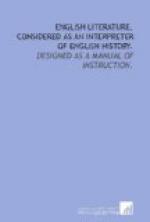Tailor, Robert, 136.
Taylor, Jeremy, 223.
Temple, Sir William, 277.
Tennyson, Alfred, 428.
Thackeray, Anne E., 465.
Thackeray, William Makepeace, 459.
Thirlwall, Connop, 441.
Thomas of Ercildoun, 59.
Thomson, James, 347.
Tickell, Thomas, 252.
Tupper, Martin Farquhar, 437.
Turner, Sharon, 448.
Tusser, Thomas, 102.
Tyndale, William, 169.
Tytler, Patrick Frazer, 446.
Udall, Nicholas, 132.
Vanbrugh, Sir John, 237.
Vaughan, Henry, 205.
Vitalis, Ordericus, 49.
Wace, Richard, 51.
Waller, Edmund, 204.
Walpole, Horace, 321.
Walton, Izaak, 202.
Warton, Joseph, 368.
Warton, Thomas, 368.
Watts, Isaac, 252.
Webster, 154.
White, Henry Kirke, 358.
Wiclif, John, 77.
William of Jumieges, 49.
William of Malmsbury, 47.
William of Poictiers, 49.
Wither, George, 203.
Wolcot, John, 367.
Wordsworth, William, 415.
Wyat, Sir Thomas, 97.
Wycherley, William, 235.
Young, Edward, 253.
THE END.
FOOTNOTES
[1] His jurisdiction extended from Norfolk around to Sussex.
[2] This is the usually accepted division of tribes; but Dr. Latham denies that the Jutes, or inhabitants of Jutland, shared in the invasion. The difficult question does not affect the scope of our inquiry.
[3] Gibbon’s Decline and Fall, c. lv.
[4] H. Martin, Histoire de France, i. 53.
[5] Vindication of the Ancient British Poems.
[6] Craik’s English Literature, i. 37.
[7] Sharon Turner, History of the Anglo-Saxons, book ix., c. i.
[8] Bosworth’s Anglo-Saxon Dictionary.
[9] Kemble ("Saxon in England”) suggests the resemblance between the fictitious landing of Hengist and Horsa “in three keels,” and the Gothic tradition of the migration of Ostrogoths, Visigoths, and Gepidae to the mouth of the Vistula in the same manner. Dr. Latham (English Language) fixes the Germanic immigration into Britain at the middle of the fourth, instead of the middle of the fifth century.
[10] Lectures on Modern History, lect, ii.
[11] Sharon Turner.
[12] Turner, ch. xii.
[13] For the discussion of the time and circumstances of the introduction of French into law processes, see Craik, i. 117.
[14] Sharon Turner’s History of the Anglo-Saxons, i. 199. For an admirable summary of the bardic symbolisms and mythological types exhibited in the story of Arthur, see H. Martin, Hist. de France, liv. xx.
[15] Craik says, (i. 198,) “Or, as he is also called, Lawemon—for the old character represented in this instance by our modern y is really only a guttural, (and by no means either a j or a z,) by which it is sometimes rendered.” Marsh says, “Or, perhaps, Lagamon, for we do not know the sound of y in this name.”




